Do the Rangers have the cap space they need to get better?

So we all got to watch Ryan McDonagh skate around the Amalie Arena with the Stanley Cup. Enough with the Lightning already, we’re grateful that they beat the Islanders, but two straight Cups is plenty. One thing about Tampa, they know how to circumvent the salary cap, something the New York Rangers have never quite figured out. We’ll get to Tampa and the salary cap later.
Now that Chris Drury can begin his remaking of the Rangers into a Stanley Cup contender, it’s time to look at the Blueshirts’ salary cap situation. Every move that he makes will be determined by the salary cap, so understanding the implications is crucial.
Assumption #1 is the cap stays flat
The salary cap will not be going up in 2021-22. It will remain $81.5 million as it was for the last two seasons. While there had been hopes that there would be some movement considering the new U.S. national television contracts, the league will be holding the line on expenses as teams still recover from the the financial hit they took from the COVID-19 pandemic.
The exact terms of the television deals have not been revealed, but the ABC contract is believed to be worth around $400 million a year and the deal with Turner Sports is supposed to be worth about $225 million annually. That’s over double the $300 million the league was making from NBC.
An additional revenue source that is just starting to percolate is from online sports betting. The American Gaming Association estimated the NHL could generate another $216 million from legalized sports betting.
That means good thing in the future when it comes to the cap, though even with a half a billion dollar increase in NHL revenue, the money still has to be divvied up among the 32 NHL teams.
So, the salary cap in 2021-22 will be $81.5 million. What does that mean for the Rangers?
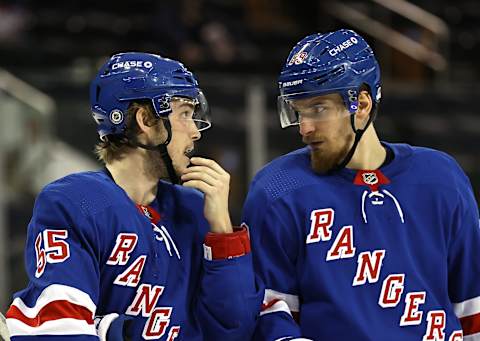
The Rangers’ cap situation
As of today, the Rangers have a projected cap hit of $58,609,801, leaving them with $22,890,199 in cap space. That includes 10 forwards, seven defensemen and two goalies for a total of 19 players under contract for 2021-22.
The team has five Restricted Free Agents (RFA’s) who need to be re-signed with two of them, Pavel Buchnevich and Igor Shesterkin, eligible for arbitration. There are two Unrestricted Free Agents (UFA’s), Brendan Smith and Phil Di Giuseppe, who probably won’t be back.
Included in the cap hit is $4,044,444 in dead cap space due to the buyouts of Henrik Lundqvist, Kevin Shattenkirk and Dan Girardi.
So, the Rangers have almost $23 million to spend on signing their RFA’s and any UFA’s that they want to target. Well, not really. There are some things that are definitely going to change.
Changes looming
There are a few things on the horizon that are guaranteed. The first is that the Rangers will definitely buy out Tony DeAngelo as soon as they get past the expansion draft. Buying him out will leave the Rangers with a $383,334 dead space cap hit next season, but it will save them $4,416,666 from DeAngelo’s salary, increasing their cap space to $27,306,865.
While that is good news, there is another issue for the Rangers and that is a potential carryover performance bonus hit. Those numbers won’t be calculated until we get closer to July 28, but there are two issues that could affect the Rangers’ salary cap.
This season the team had a performance bonus exposure of $8.35 million. Next season the team has an exposure of $7.55 million in performance bonuses. This season, teams were allowed to pay out $6,112,500 in performance bonuses without it affecting the cap. Anything paid over that total is added to the next year’s salary cap and the possible hit is $2,237,500.
What we don’t know is how much of that $8.35 million was actually earned in 2020-21. We can be pretty sure that Adam Fox got his $850k and K’Andre Miller earned hi $300k. But what about Kaapo Kakko and his $2.65 million in bonus money? Did Alexis Lafrenière or Igor Shesterkin earn their total of $2.85 million each in performance bonuses? Was the 20 games Vitali Kravtsov played enough to trigger the $850k in bonus money for him?
The bottom line is it’s possible that the $27,306,865 in cap space could drop by as much as $2.2 million. But how much will they need to pay their pending free agents?
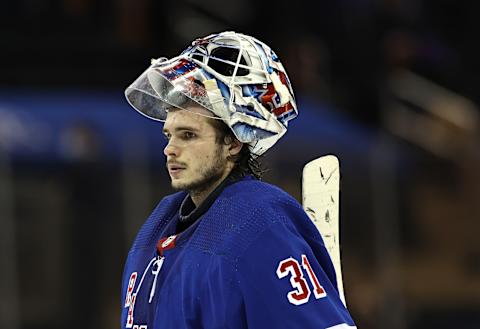
Contract estimates
Let’s say that the Rangers eat the maximum performance bonus hit. It leaves them with $25 million in cap space. But they need to use that to sign their free agents. Here’s a ballpark for their restricted free agents.
Pavel Buchnevich has arbitration rights and is coming off two excellent seasons. Signed to a two-year bridge deal for $3.25 million he will be looking for raise and it will probably be in the range that Ryan Strome signed for last summer. Let’s estimate $5 million on a one year deal.
Igor Shesterkin is the other arbitration eligible RFA and Chris Drury will have to decide if he wants to roll the dice and sign him to a long term contract. Shesterkin is 25 so he is not a kid and a five or six year deal for about $5 million sounds right.
The Rangers went out and signed Brett Howden to a one year deal worth $885k and it’s very likely that that’s where they will end up when it comes to RFA’s Julien Gauthier, Filip Chytil and Libor Hajek. We will round them up to $1 million.
That means they will spend $13 million for their five RFA’s. That gives the Rangers a cap hit of approximately $69.7 million for 13 forwards, seven defensemen and three goalies.
Add Morgan Barron to the roster and it offsets Keith Kinkaid’s salary since the team will carry only two goalies on the big league roster.
An NHL team can carry a maximum roster of 23 players that count against the cap so with these 23 players, the team is about $11.5 million below the cap. What does that roster look like?
Forwards (14): Morgan Barron, Colin Blackwell, Pavel Buchnevich, Filip Chytil, Julien Gauthier, Brett Howden, Kaapo Kakko, Vitali Kravtsov, Chris Kreider, Alexis Lafrenière, Artemi Panarin, Kevin Rooney, Ryan Strome, Mika Zibanejad
Defensemen (7): Tony Bitetto, Adam Fox, Libor Hajek, Zac Jones, Ryan Lindgren, K’Andre Miller, Jacob Trouba.
Goalies (2): Igor Shesterkin, Alexandar Georgiev
So, the Rangers could field the exactly same team that ended the season, minus Phil Di Giuseppe and Brendan Smith and still have $11.5 million to play with. But, there is also one player on this list who probably won’t be with the team next year. That means some other options when it comes to the cap.
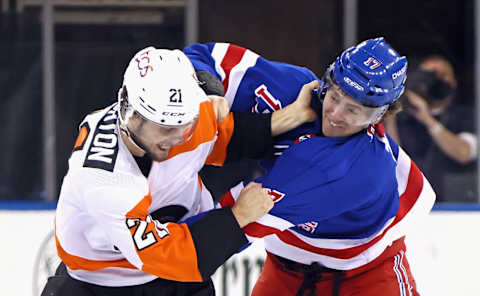
One sure thing and options
There is one sure thing when it comes to the roster listed above. One of those players will be drafted by the Seattle Kraken later this month. It doesn’t mean a lot when it comes to the salary cap as whoever is drafted (Gauthier, Howden, Hajek, Blackwell, Bitetto, Rooney?) will have a cap impact of less that $1 million.
It’s pretty much a guarantee that the Rangers will acquire a veteran defenseman to bring some experience to their blueline. That player is will replace either Bitetto or Hajek on the active roster.
Chris Drury will also be looking to add some muscle and faceoff ability to the bottom six and that means a replacement for Gauthier, Howden, Blackwell or Rooney on the active roster unless he trades someone like Buchnevich.
What it means is the Rangers will really have almost $14 million to spend to try to fill the holes in the lineup and make the team harder to play against. It’s not necessarily a free agent signing for Drury, he can also look to trade for a player who will have to be exposed by another team in the expansion draft. Acquiring that kind of player will mean that the team will have to expose someone like Howden, Gauthier or Blackwell, but if it is an upgrade, Drury won’t hesitate.
So, it means that the Rangers have a great deal of flexibility, much more than most other NHL teams. According to capfriendly.com, 10 NHL teams currently have more cap space than the Rangers and 21 teams have less. It’s a misleading statistic as that cap space doesn’t include RFA’s and UFA’s on the roster.
The Rangers could actually have more real cap space than most teams in the NHL this off-season. That means they are a realistic contender for a player like Phillip Danault, a pending UFA who dazzled during the Stanley Cup Playoffs with his defensive play and faceoff prowess. Montreal would love to re-sign him, but they currently have $14.6 million in cap space and only 15 players under contract.
All of this cap space could vanish in a nano second if Drury is aggressive in the trade market.
Now, let’s get back to Tampa and what Drury could learn from them.
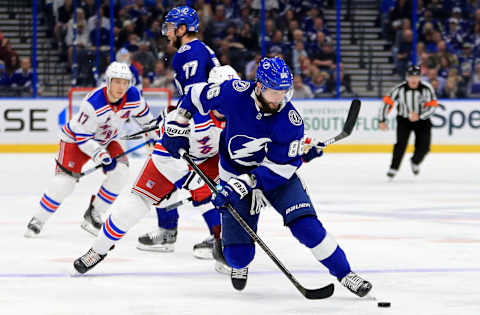
What about Tampa?
There’s no denying that the Tampa Bay Lightning are a great championship team. There is also no question that GM Julien BriseBois took advantage of a salary cap loophole that makes the cap apply only to the regular season and not the playoffs. The simple fact is that Nikita Kucherov was on Long Term Injured Reserve (LTIR) for the entire regular season after hip surgery and that meant that his $9.5 million cap hit was waived allowing the Lightning the flexibility to even add to the roster at the trade deadline.
BriseBois engineered a three-way trade for defenseman David Savard that was pure cap genius. He got Columbus to trade Savard to his old boss, Steve Yzerman in Detroit for Brian Lashoff and Tampa’s fourth round 2021 draft pick. Yzerman traded Lashoff and Savard to Tampa. The Lightning sent a 2021 first round pick and a 2022 third round pick to Columbus. The key was that Columbus retained the maximum 50% of Savard’s salary in the trade to Detroit. Then Detroit retained 50% of what was left in the trade to Tampa. That meant that the cap-strapped Lightning had to pay only 25% of Savard’s salary for the remainder of the season. Savard played in 20 of the 23 Lightning playoff games.
That folks, is how you win Stanley Cups. It is also how you use NHL loopholes to get around the salary cap and Chris Drury would be well advised to learn from that.
Some have pushed for the salary cap to be extended into the playoffs or at least the first round. Some have also recommended that the 50% salary retention limit be applied once in trade whether it is a two-way or three-way deal. The funny thing is no one wants to change the rules.
That’s because NHL general managers are copycats and they can see themselves using the same rules in the future. The Blackhawks used he LTIR loophole in 2015 when they won the Cup. They put Patrick Kane and his $10.5 million salary on LTIR and they were able to acquire Antoine Vermette, Andrew Desjardins and Kimmo Timonen at the deadline. All three were key players for the Hawks’ Cup run and Kane came back in time to lead the NHL in playoff scoring.
With the NHL reluctant to close these loopholes, all we can recommend is that Mr. Drury pay close attention. Of course, if it was the Rangers trying to use such loopholes, we all know that the NHL would crack down on them immediately.
So where are we when it comes to the Rangers’ salary cap?
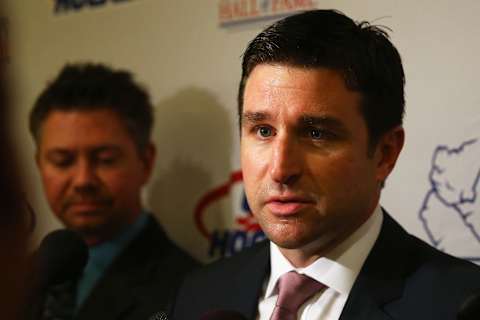
Back to the Rangers
The Rangers have about $14 million to spend this off-season in their quest to be a tougher team to play against and be able to win more faceoffs than they lose. They have to be mindful that starting in 2022-23 they will have to pay major dollars to Adam Fox and possibly Mika Zibanejad while Kaapo Kakko and Vitali Kravtsov will be up for renewal as well.
The good news is we should see an increase in the salary cap for that season. Don’t forget that prior to the pandemic, the estimate was the cap would increase anywhere from $84 to $88.2 million in 2020-21.
It’s always a guessing game when it comes to the cap, but for the first time in years, the Rangers are actually in a good position and will able to add assets. It all is set to happen in the next few weeks. Here are the key dates coming up.
- Thursday, July 8 – Buyout period opened (ends on July 27). The Rangers are expected to buy out Tony DeAngelo,but will wait until after the expansion draft when he will be exposed.
- Saturday, July 17 (5pm) – Deadline for teams to submit protected lists for 2021 NHL Expansion Draft.
- Wednesday, July 21 (8pm) – 2021 NHL Expansion Draft.
- Thursday, July 22 (5pm) – Deadline for teams to extend qualifying offers to pending Restricted Free Agents (RFA’s). Rangers include Buchnevich, Chytil, Gauthier, Hajek and Shesterkin. Prospects include Brandon Crawley, Gabriel Fontaine, Tim Gettinger, Adam Huska, Patrick Newell, Ty Ronning and Yegor Rykov.
- Friday, July 23 – First round of 2021 NHL Draft. The Rangers pick 15th.
- Saturday, July 24 – Rounds 2-7 of 2021 NHL Draft. The Rangers have no second round picks, two third round picks, three fourth round picks and one pick in the fifth, sixth and seventh rounds.
- Tuesday, July 27 – Last day for teams to sign pending Unrestricted Free Agents (UFA’s) to eight-year contract extensions. No Rangers are in this category.
- Wednesday, July 28 (12 pm) – Free agent frenzy begins. Rangers’ UFA’s are Phil Di Giuseppe, Jack Johnson, Brendan Smith and prospect Darren Raddysh.
- Sunday, August 1 (5pm) – Deadline for RFA’s to file for salary arbitration. Rangers RFA’s eligible for arbitration include Pavel Buchnevich, Igor Shesterkin, Brandon Crawley, Patrick Newell and Yegor Rykov.
- Monday, August 2 (5pm) – Deadline for teams to file for salary arbitration.
- Tuesday, August 17 to Wednesday, September 1 – Salary arbitration hearings.
- September (TBA) – Traverse City Prospects Tournament.
- Tuesday, September 21 – Training camps open.
- Tuesday, October 12 – 2021-22 regular season begins (tentative date).
More. A history of Blueshirt coaches in their first years. light
Thanks to capfriendly.com and puckpedia.com for a wealth of salary cap data.